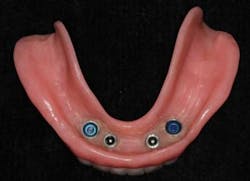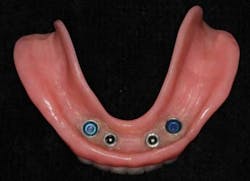A simple solution to a common problem
For more on this topic, go to www.dentaleconomics.com and search using the following key words: veneers, crowns, orthodontic procedures, Komet OS30, fluoride, Dr. Joe Massad.
Welcome back! This month’s tip involves a simple solution to a problem that many dentists, including myself, have encountered. This problem is the accidental abrading or ditching of adjacent tooth structures when prepping for veneers or crowns, or simply opening contacts for orthodontic procedures.
I would like to describe an oscillating instrument with either a single cutting side offered on either side of the half disc design, or offered with a double cutting side. This instrument, called the OS System by Komet, was designed for safe interproximal enamel reduction and does not require the use of a disc guard.
Very simply, insert a diamond strip using gentle manual separation into the noncutting area. Next, take the oscillating handpiece and insert the segmented discs in one of the many offered positions to engage the desired tooth or teeth to the ideal ergonomic location for ease of operator use. The disc is exclusively designed for use in the Oscillating Komet Contra-Angle OS30 Handpiece. There is a 6-mm diamond coating on each disc that produces excellent grinding efficiency.
The operating angle of the disc is 30 degrees moving 15 degrees in each direction. I engage the handpiece before performing a proximal reduction to make sure that the disc is at the right angle, and I have the proper cutting side and safety side in the proper location prior to insertion. The discs come in different thicknesses and grids. Using this system results in minimum reduction to tooth structure.
Because there are eight positions that allow for optimum access in both lingual and buccal areas of the mouth, the risk of injuring soft tissue is virtually eliminated. It is safer and more comfortable for the patient. It reduces the risk of gingival injury and results in less time in the chair.
Once opening the contact with the diamond end is completed, a compo-system polisher is used, which is offered in three grits color coated from coarse to fine. Fluoride is applied to the enamel surface after treatment.
Rotated and crowded teeth are a challenge when trying to avoid damaging the adjacent tooth while preparing for veneers or full crowns. As seen in my online video, this system allows the practitioner a safety net by using the cutting side of the disc to open the contact, while the noncutting side protects the adjacent tooth. The simplicity of this approach allows the practitioner a simple solution that can be performed in less time, and provides a precision cut to produce clinical excellence for all patients.
I hope this tip will help you as much as it has me. For the full video step-by-step version, go to www.dentistryiq.com. See you next month. I hope my pleasure in dentistry will also be yours ... Joe Massad.
Dr. Joseph Massad may be reached by phone at (918) 749-5600 or by e-mail at [email protected].


